
Riesling is a white grape variety that originated in the Rhine region. Riesling is an aromatic grape variety displaying flowery, almost perfumed, aromas as well as high acidity. It is used to make dry, semi-sweet, sweet, and sparkling white wines. Riesling wines are usually varietally pure and are seldom oaked. As of 2004, Riesling was estimated to be the world's 20th most grown variety at 48,700 hectares, but in terms of importance for quality wines, it is usually included in the "top three" white wine varieties together with Chardonnay and Sauvignon blanc. Riesling is a variety that is highly "terroir-expressive", meaning that the character of Riesling wines is greatly influenced by the wine's place of origin.

Gewürztraminer is an aromatic wine grape variety, used in white wines, and performs best in cooler climates. In English, it is sometimes referred to colloquially as Gewürz, and in English and French it is written Gewurztraminer. Gewürztraminer is a variety with a pink to red skin colour, which makes it a "white wine grape" as opposed to the blue to black-skinned varieties commonly referred to as "red wine grapes". The variety has high natural sugar and the wines are white and usually off-dry, with a flamboyant bouquet of lychees. Indeed, Gewürztraminer and lychees share the same aroma compounds. Dry Gewürztraminers may also have aromas of roses, passion fruit and floral notes. It is not uncommon to notice some spritz.
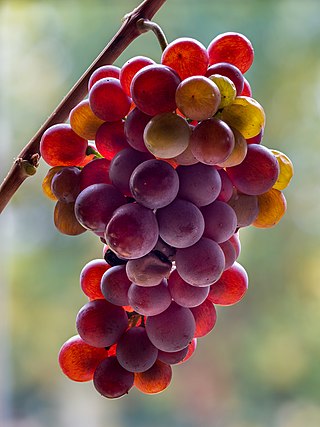
Pinot Gris, Pinot Grigio or Grauburgunder is a white wine grape variety of the species Vitis vinifera. Thought to be a mutant clone of the Pinot Noir variety, it normally has a grayish-blue fruit, accounting for its name, but the grapes can have a brownish pink to black and even white appearance. The word pinot could have been given to it because the grapes grow in small pinecone-shaped clusters. The wines produced from this grape also vary in color from a deep golden yellow to copper and even a light shade of pink, and it is one of the more popular grapes for skin-contact wine.

White wine is a wine that is fermented without skin contact. The colour can be straw-yellow, yellow-green, or yellow-gold. It is produced by the alcoholic fermentation of the non-coloured pulp of grapes, which may have a skin of any colour. White wine has existed for at least 4,000 years.

Trockenbeerenauslese, or TBA, is a German language wine term for a medium to full body dessert wine.

German wine is primarily produced in the west of Germany, along the river Rhine and its tributaries, with the oldest plantations going back to the Roman era. Approximately 60 percent of German wine is produced in the state of Rhineland-Palatinate, where 6 of the 13 regions (Anbaugebiete) for quality wine are situated. Germany has about 103,000 hectares of vineyard, which is around one tenth of the vineyard surface in Spain, France or Italy. The total wine production is usually around 10 million hectoliters annually, corresponding to 1.3 billion bottles, which places Germany as the eighth-largest wine-producing country in the world. White wine accounts for almost two thirds of the total production.

Spätlese is a German wine term for a wine from fully ripe grapes, the lightest of the late harvest wines. Spätlese is a riper category than Kabinett in the Prädikatswein category of the German wine classification and is the lowest level of Prädikatswein in Austria, where Kabinett is classified in another way. In both cases, Spätlese is below Auslese in terms of ripeness. The grapes are picked at least seven days after normal harvest, so they are riper and have a higher sugar content. Because of the weather, waiting to pick the grapes later carries a risk of the crop being ruined by rain. However, in warm years and from good sites much of the harvest will reach Spätlese level.
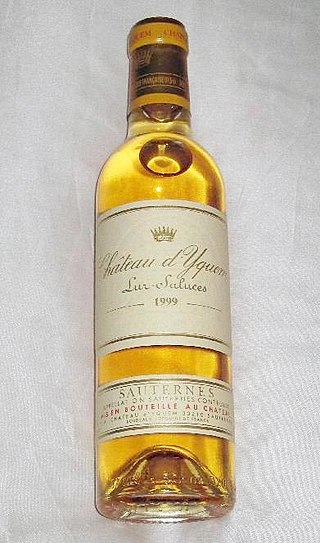
The subjective sweetness of a wine is determined by the interaction of several factors, including the amount of sugar in the wine, but also the relative levels of alcohol, acids, and tannins. Sugars and alcohol enhance a wine's sweetness, while acids cause sourness and bitter tannins cause bitterness. These principles are outlined in the 1987 work by Émile Peynaud, The Taste of Wine.
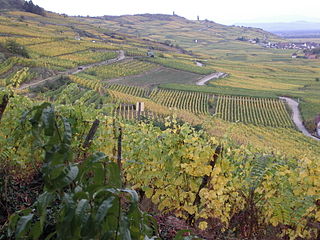
Alsace wine or Alsatian wine is produced in the Alsace region in France and is primarily white wine. Because of its Germanic influence, it is the only Appellation d'Origine Contrôlée region in France to produce mostly varietal wines, typically from similar grape varieties to those used in German wine. Along with Austria and Germany, it produces some of the most noted dry Rieslings in the world as well as highly aromatic Gewürztraminer wines. Wines are produced under three different AOCs: Alsace AOC for white, rosé and red wines, Alsace Grand Cru AOC for white wines from certain classified vineyards and Crémant d'Alsace AOC for sparkling wines. Both dry and sweet white wines are produced.

Alsace Grand Cru is an Appellation d'Origine Contrôlée for wines made in specific parcels of the Alsace wine region of France. The Grand Cru AOC was recognized in 1975 by the INAO with subsequent expansion in 1983, 1992 and 2007.
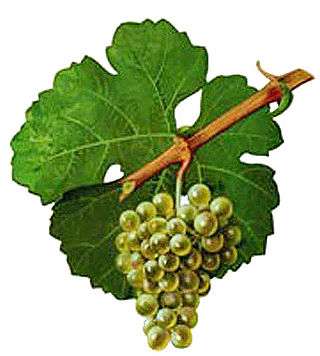
Sylvaner or Silvaner is a variety of white wine grape grown primarily in Alsace and Germany, where its official name is Grüner Silvaner. While the Alsatian versions have primarily been considered simpler wines, it was included among the varieties that can be used to produce Alsace Grand Cru wine in 2006, together with the four 'noble grapes' of Alsace, although only in one vineyard, Zotzenberg.
The glossary of wine terms lists the definitions of many general terms used within the wine industry. For terms specific to viticulture, winemaking, grape varieties, and wine tasting, see the topic specific list in the "See also" section below.

Brown Brothers Milawa Vineyard is a family-owned wine company based in Milawa, Victoria, Australia. Brown Brothers was founded in 1889 by John Francis Brown and continues to be owned and operated by his descendants on the original property. Brown Brothers makes wine from a wide range of grape varieties and into a range of styles.

Moselle wine is produced in three countries along the river Moselle: France, Luxembourg and Germany. Moselle wines are mainly white and are made in some of the coldest climates used for commercial winemaking.
Sélection de Grains Nobles (SGN) is French for "selection of noble berries" and refers to wines made from grapes affected by noble rot. SGN wines are sweet dessert wines with rich, concentrated flavours. Alsace wines were the first to be described as Sélection de Grains Nobles, with the legal definition introduced in 1984, but the term is also seen in some other wine regions France, such as Loire.

Luxembourg wine is primarily produced in the southeastern part of the Grand Duchy of Luxembourg, with vineyards overlooking the river Moselle. Along this river, which for 42 km makes up part of the border between Luxembourg and Germany, wine is made in three countries. There is a continuous history of winemaking along Moselle and in Luxembourg going back to Ancient Roman times. Wine production in 2006/07 was 123,652 hectoliter from 1,237 hectares of vineyards. Out of total wine exports of 87,776 hectoliter in 2005/06, 71,726 hectoliter or 82% was exported to nearby Belgium. Exports to Germany were the second largest at 8,168 hectoliter, or 9%, and is to a large extent made up of base wine in bulk for the production of blended Sekt rather than being sold bottled with "Luxembourg" anywhere on the label. Therefore, very little Luxembourg wine is seen outside Luxembourg and Belgium.

Hugel & Fils is a winery in Riquewihr, Alsace, France. Hugel & Fils is one of the major producers of Alsace wine, and has been an important force in the Alsace wine industry in its developments during the second half of the 20th century.
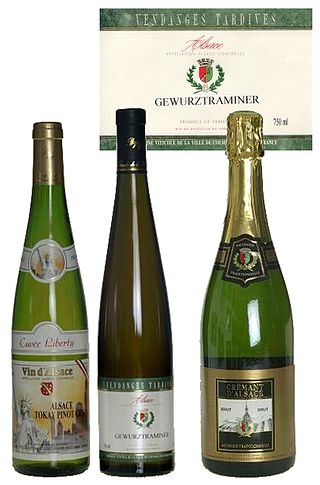
The wine region of Alsace produces wines under three different Appellations d'Origine Contrôlées (AOCs): Alsace AOC for white, rosé and red wines, Alsace Grand Cru AOC for white wines from certain classified vineyards and Crémant d'Alsace AOC for sparkling wines. This region is the only French wine region allowed to label its wines based on variety.
Marcel Deiss is a French wine grower and producer. It is based in Bergheim, in the Alsace wine region of France.
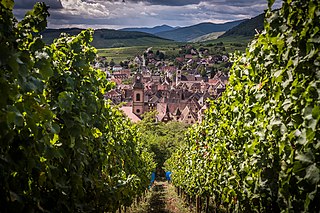
The Alsatian Grand Cru vineyard Schoenenbourg is situated north of the village Riquewihr. The vineyard faces south and south-east on the steep hill Schoenenbourg. The altitude of the vines are between 265 and 380 meters and covers 53.4 ha og Keuper subsoil with marl, gypsum and dolomite.


















